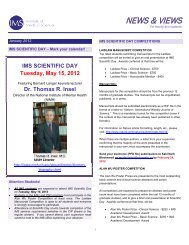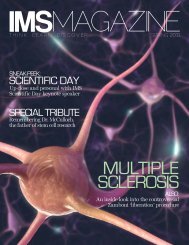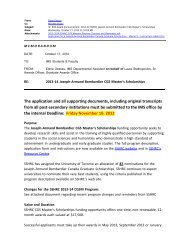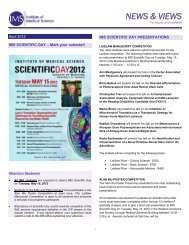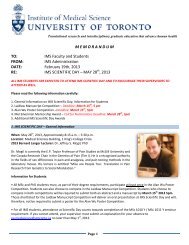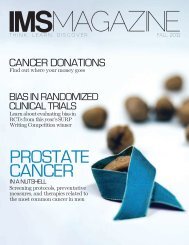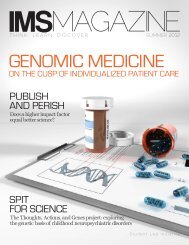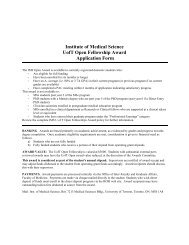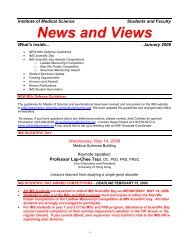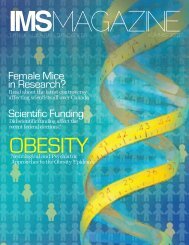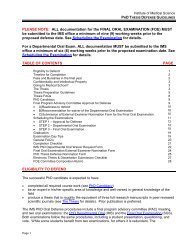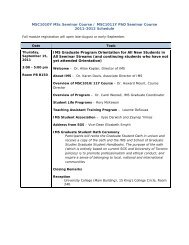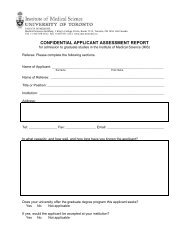MSc Examination Guidelines - Institute of Medical Science
MSc Examination Guidelines - Institute of Medical Science
MSc Examination Guidelines - Institute of Medical Science
You also want an ePaper? Increase the reach of your titles
YUMPU automatically turns print PDFs into web optimized ePapers that Google loves.
<strong>Institute</strong> <strong>of</strong> <strong>Medical</strong> <strong>Science</strong><strong>MSc</strong> Thesis Defense <strong>Guidelines</strong>9. THESIS PREPARATION GUIDELINESFormatYour thesis may be prepared in a continuous “traditional format”, with the in depth Literature Review,Aims/Hypotheses, detailed Methods section, data presented in a central Results section and aDiscussion that describes the plausible range <strong>of</strong> interpretations for your work, followed by theConclusions and Future Directions. Alternatively, you may choose a "paper format". In this case,your thesis work is organized as a series <strong>of</strong> self-contained chapters (each containing a focusedIntroduction, Methods, Results, Discussion/Conclusion) , similarly reformatted for consistency andframed by common in depth Literature Review, Aims/Hypotheses, and General Discussion,Conclusions, and Future Directions chapters. The decision as to which format to use is best madeearly in the writing process, in consultation with your supervisor. In general, the choice depends uponthe stage you are at in the preparation <strong>of</strong> publications and whether your thesis is most readily viewedas one continuous work or a set <strong>of</strong> discrete, but related studies that together tell your story. Bring inyour proposed Table <strong>of</strong> Contents and the Graduate Coordinators will be glad to look it over.AbstractThe central hypothesis, rationale and research aims should be clearly and explicitly laid out, alongwith interpretation <strong>of</strong> the results for each component <strong>of</strong> your experimental work. State what you havefound rather than “results will be discussed.” Keep technical jargon and discussion <strong>of</strong> background to aminimum. Endeavour to explain the findings and their significance at a level that is understandable tosomeone working outside your field <strong>of</strong> interest. The limit for a master’s thesis abstract is 150 words.Acknowledgments and ContributionsExplicitly acknowledge the contributions <strong>of</strong> technicians, trainees, collaborators, faculty mentors andfunding sources to the experimental work, analyses and writing <strong>of</strong> the thesis. Be precise, inclusiveand accurate. Personal thanks to friends and family may also be included. A listing <strong>of</strong> the specificcontributions <strong>of</strong> others is sometimes presented as a separate section immediately followingAcknowledgments. Images, data and text taken, or adapted from material on the web, papers, orbooks, require attribution and cannot be used without permission from the copyright owner. Be sureto include formal letters <strong>of</strong> permission to incorporate any published materials in your thesis. Moreinformation on copyright issues and a template for preparing copyright letters <strong>of</strong> permission areavailable online from the SGS (http://www.sgs.utoronto.ca).List <strong>of</strong> AbbreviationsAll but universally accepted abbreviations, such as units <strong>of</strong> measure, should be listed and should beexplained in the thesis text on the page where they are first used. For guidance on whatabbreviations need not be listed, consult the Council <strong>of</strong> <strong>Science</strong> Editors Manual for Authors, Editors,and Publishers (available through the U<strong>of</strong>T Gerstein Library, or for purchase athttp://www.councilscienceeditors.org), for the instructions to authors provided by respected journals inyour discipline.List <strong>of</strong> Figures and List <strong>of</strong> TablesFigure titles should be short and self-explanatory. Leave details to the legends. All figures require alegend. Remember to include error bars. By skimming the figures and legends, a reviewer should geta clear sense <strong>of</strong> the results in your thesis.Literature ReviewThe Literature Review is a scholarly review <strong>of</strong> the background to your research question. It framesyour work with reference to the history <strong>of</strong> your research question, relevant theories and the clinicalpicture, if appropriate. Concepts and terminology that are used in your research should be explainedand you should provide a review <strong>of</strong> technologies, approaches and analytical methods that you use.Where there are gaps in the literature that your thesis addresses, point these out and mention howPage 51-Oct-12



